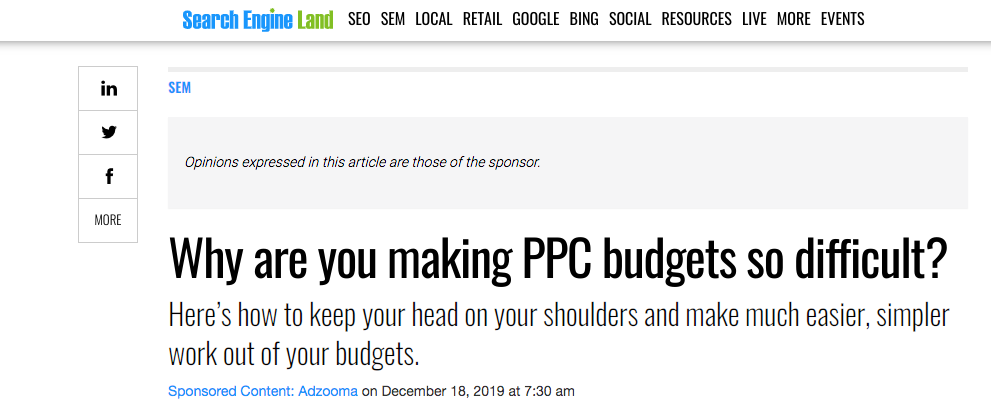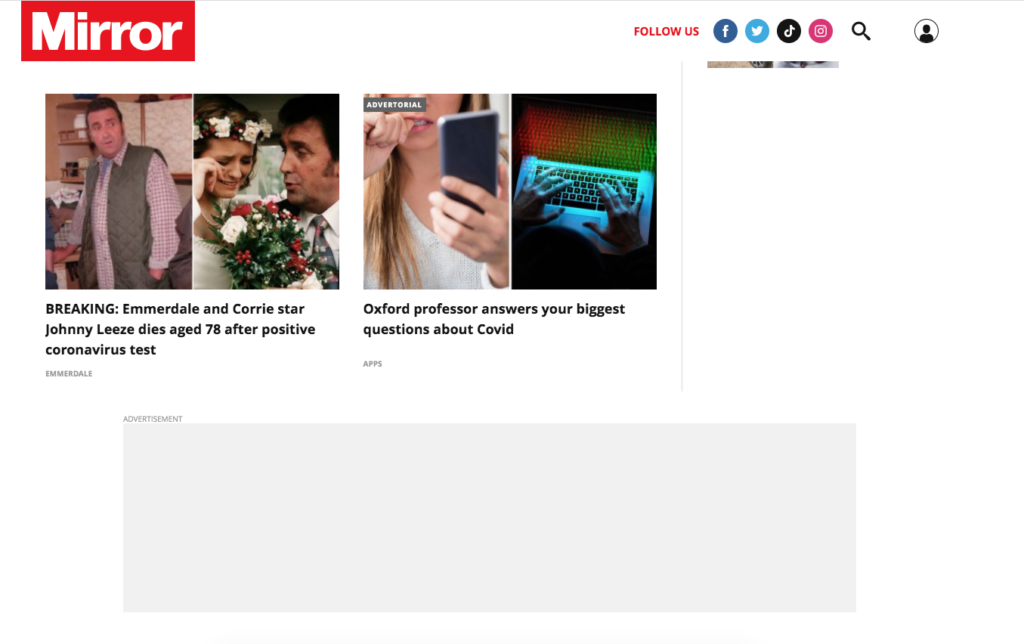Native ads are on the rise as savvy shoppers become increasingly aware of the fact they’re being sold to on every corner of the internet. This year, almost two-thirds of display spend will be on native ads. Why? For starters, native ads receive 53% more attention and 18% more purchase intent in comparison to banner ads.
These native ads are big on social media, with Facebook reporting over 86% of impressions on its Audience Network coming from native ads. But there’s so much more to native advertising than blending in on people’s news feeds – it’s just knowing which sites can offer you new types of customers.
What are native ads?
Native ads are the chameleons of the advertising word. Difficult to spot, these ads are a seamless way of attracting your target audience without being obviously ‘selly’. A native advert is an ad which blends in with a website’s surroundings. It matches the tone and topic of the place it is shown so that readers easily mistake it for organic content.
This style of ad is beneficial for both advertisers and the sites where display ads are shown: advertisers are more likely to get clicks because readers are already interested in their products/services, and websites don’t come across as though they’ve sold their souls for monetary gain.
Native ads can be difficult to spot due to the lack of guidelines surrounding them. With no defined labelling laws in place, it varies from site to site as to how things should look. What defines a native ad as such is that it avoids the traits you would expect from a typical ad; native ads move away from buzzwords such as ‘buy’, ‘sale’ and ‘subscribe’ and instead favour brand awareness as a common goal.
Taboola
What is Taboola?
Taboola is the world’s largest discovery platform serving 360 billion content recommendations to one billion people online each month. Companies like Taboola have partnerships with popular sites which you can gain advertising space on just by signing up. Because of the sheer size of Taboola, they cater for pretty much every niche out there. Their biggest partnerships are with the likes of Bloomberg, NBC News, MSN and The Independent.
How Taboola works
Taboola uses AI technology to feed native ads in front of users who are likely to be interested. It aims to put content and products in the paths of people as they’re browsing for entertainment – they’re not looking to be sold to. Because of the way native ads blend in, audiences don’t feel like they’re being bombarded with ads and are more likely to click.
Taboola has a strong relationship with thousands of top websites and apps. It has a ‘predictive engine’ which analyses your ads and matches them with ad space across its Publisher Network where it thinks you’ll see the best results.
Taboola’s algorithm is designed to learn from your results and make adjustments as it sees fit. It accesses user data including everything from browsing history, device, location, reading preferences and more and uses this information to drive more clicks.
There are lots of advanced targeting options and full data transparency so you’re free to go in and make your own tweaks as you like.
How much does Taboola cost?
Ads on Taboola’s network operate on a cost-per-click model so it’s difficult to say how much ads for your industry would be. Whilst there’s no free trial or soft-launch option, you can go down a self-service route which starts at $10 a day but is only available in certain regions.
If you think Taboola might be the right option for your business, you can sign up here.
Outbrain
Outbrain is very similar to Taboola. It runs on a cost-per-click system and is a content discovery platform which feeds native ads to relevant audiences. Whilst it works on the same basis, there are small differences – this comparison table tells you all you need to know.
There was talk of an $850 million merger happening between Taboola and Outbrain which ended up being unsuccessful, but that highlights the similarities of their business models.
Outbrain’s publisher base consists of well-known brands such as MSN, CNN, BBC and The Washington Post. One of the biggest things to consider when choosing between companies such as Outbrain and Taboola is who their client base is; whilst both offer a huge variety, your favourite platform may feature on one rather than than the other and help to sway your final decision. Microsoft, for example, works closely with Outbrain and so if you run Microsoft ads you might find it’s the easiest way to tie your strategies together.
Sponsored Content
Another interesting form of native advertising is sponsored content. This is where you pay a site to publish your advertorial; you write an article in the style of their specialist content so it merges in with its surroundings and subtly push your product or service.
To get this sort of content approved, you first need to build a relationship with the publisher. Most sites offer this service as it’s a good way for them to make money and diversify their content, so there might be a wealth of options to choose from depending on your industry. Once you know to look out for the ‘sponsored content’ tag, you’ll see advertorials all around you.
This is something we offer here at Adzooma. For a small fee, you can reach out to our monthly audience of 40,000 users – get in touch if this is something you’d like to do.
This example from Search Engine Land has clear labels showing it to be a sponsored article – other sites may be more subtle.

A huge advantage of advertorials is they aren’t blocked by ad blockers.
This example from The Mirror shows how the ad below the articles doesn’t show, but the sponsored articles do.

Another benefit is that sponsored content allows you to inform, entertain and engage with your audience which in turn strengthens your relationship – you’re much more likely to stick in their mind if they’re interested in reading your piece, in comparison to just a few seconds glancing at your ad.
The cookies are being eaten
Something to bear in mind is the fact Google plans on banning all third party cookies in the future. The move is designed to increase user privacy and follows what Safari and Firefox did way back in 2013. First-party cookies are safe – for now.
This probably isn’t shocking to most marketers as it’s a change which has been long-awaited. However, if you’re an advertiser that relies on third-party cookie data to analyse your visitor’s behaviour across other sites, then this change may impact your advertising strategy.
You won’t lose the tracking data of how users behave on your own site, but you will no longer be able to access the cookie trail they’ve left across the web.
Subtle advertising is the future
Users are a lot savvier these days – they know when they’re being sold to. Native PPC ads and sponsored content are great ways to appeal to your target audience in their natural habitat. Advertising on sites which offer similar content enables you to blend in and come across in a much more genuine way.
Subtle is the way forward.
Ready for more?
If you’re looking for other alternative ways to advertise than on Google, Facebook and Microsoft, check out the other articles in my PPC Alternatives series:
- 16 Best PPC Alternatives To Google Ads, Facebook Ads, and Microsoft Ads
- Amazon vs. eBay vs. Etsy: Which Is Best For PPC Ads?
- Snapchat Ads vs. Twitter Ads vs. LinkedIn Ads: Which Is Best For Paid Social?
There’s a whole lot more to PPC than search engines, don’t miss out on potential customers by limiting yourself.




